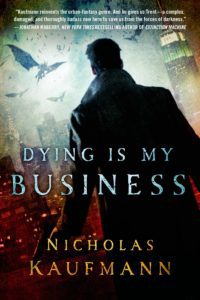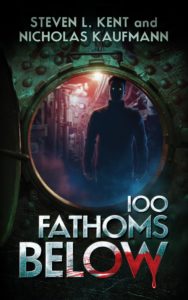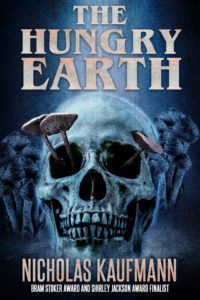 Nicholas Kaufmann is the Bram Stoker Award-nominated, Thriller Award-nominated, Shirley Jackson Award-nominated, and Dragon Award-nominated author of numerous works of horror and dark fantasy, including the bestsellers 100 Fathoms Below (written with Steven L. Kent) and The Hungry Earth. His short fiction has appeared in Cemetery Dance, Black Static, Nightmare Magazine, Interzone, and others. In addition to his own original work, he has written for such properties as Zombies vs. Robots, The Rocketeer, and Warhammer.
Nicholas Kaufmann is the Bram Stoker Award-nominated, Thriller Award-nominated, Shirley Jackson Award-nominated, and Dragon Award-nominated author of numerous works of horror and dark fantasy, including the bestsellers 100 Fathoms Below (written with Steven L. Kent) and The Hungry Earth. His short fiction has appeared in Cemetery Dance, Black Static, Nightmare Magazine, Interzone, and others. In addition to his own original work, he has written for such properties as Zombies vs. Robots, The Rocketeer, and Warhammer.
What first attracted you to horror writing?
Monsters. It may seem like an obvious answer, but it was actually a rather circuitous route. Bear with me while I try to explain. I grew up reading science fiction and fantasy, not all of it good but all of it filled to the brim with imagination and creativity, which is what initially attracted me to the genres. What I loved most about science fiction were the alien lifeforms, how unlike us they were. What I loved most about fantasy were the creatures—centaurs and griffins, ogres and dragons. Coupled with my (still enduring) love of Godzilla and Sinbad movies, I eventually realized that what I loved most were monsters.
Of course, horror isn’t all about monsters, but monsters were my gateway. I loved dinosaurs as a kid because they looked like monsters. I fell in love with horror movies before I knew much about horror fiction. Even dopey horror films, like 1977’s The Car, which was the first horror movie I ever saw in a movie theater, lit up my imagination like a flare. Sure, it’s a crappy movie about James Brolin going up against a demonically possessed two-door sedan, but to little eight-year-old me, it was an eye-opening experience. I realized that scary things excited me, as long as they were presented to me in a safe manner, such as in movies or on TV or in comic books. Oh, those horror comic books! I couldn’t wait to get my hands on the next issues of Creepy, Eerie, House of Mystery, House of Secrets, and probably a dozen more whose titles are lost to time. The things I enjoyed got scarier and scarier.
I’ve probably told this story a million times in interviews, but I didn’t start reading adult horror fiction until 1986, when I walked into Forbidden Planet in New York City (the short-lived 59th Street branch, which was near where I lived at the time) and saw three slim paperbacks with cheesy but eye-catching Halloween masks on the covers. They were the first three volumes of Clive Barker’s Books of Blood, published in the U.S. by Berkley. Paperbacks were cheap then, each one only cost $2.95, so I picked up all three and absolutely devoured them. Reading Barker was an even bigger eye-opener for me. He showed me what horror fiction could be, what it was capable of, and that’s when I knew what I wanted to write instead of the boring science fiction and fantasy knockoffs I was pounding out on my father’s old electric typewriter.
So, what attracted me to horror writing? If I’m trying to sound fancy, I tell people it was the day I discovered Barker. But the unvarnished truth is, I just thought monsters were really cool.
 What is your most notable work?
What is your most notable work?
Honestly, I don’t know how to answer this question. I’m not sure it’s for an author to decide which of his works is most notable. I think maybe that’s for the readership or history to decide.
If we’re talking about which of my books has sold the most, it’s probably Dying is My Business, the first in the urban fantasy series I did with St. Martin’s. Unfortunately, the second book hardly sold any copies at all, so the series didn’t go any further. The vampire novel I wrote with Steven L. Kent, 100 Fathoms Below, is also pretty notable, if only because a tweet I made about it went viral and got picked up by a bunch of websites. Believe it or not, a viral tweet actually moves books!
My most notable piece of short fiction might surprise you because it’s erotica, not horror. My story ‘Comeback’, which first appeared on Fishnet, is the most reprinted of my stories, appearing in The Best American Erotica 2007 and X: The Erotic Treasury, and was also excerpted on the Playboy website. I wish any of my horror short stories had done as well as that one!
What are you working on now?
Right now, I’m in the research and outlining phase of the third book in the Dr. Laura Powell series after The Hungry Earth and The Stone Serpent. The good folks at This Is Horror have been so great about getting the word out about both those books, I really appreciate it! The third one doesn’t have a title yet, but among the things I’m researching are parasitic wasps and how melting permafrost from climate change could release ancient and deadly viruses, bacteria, and microorganisms into the world. Both are frightening and fascinating topics.
In 2016, melting permafrost in Siberia uncovered the carcass of a reindeer that died from an anthrax infection some 75 years before, and as the carcass warmed up, the anthrax was revived and went on to cause the death of one person and the hospitalization of dozens of others. What else might be uncovered as the ice continues to melt? The bodies of smallpox victims? Bubonic plague victims? Could those pathogens be released into the world again? It’s scary to think about, and that’s why I wanted to do something with it in the next book.
I think the phrase “by the seat of my pants” sums it up pretty well! I’m actually an outliner, at least for my novels, because I need to know the progression of events before I start writing the manuscript, otherwise I end up staring at a blinking cursor, utterly paralyzed about what should happen next. I have a great deal of respect for those who work without an outline—something I’ve only recently learned is called “discovery writing”—but I can’t do it. I’ve tried, and I fail each time. Of course, an awful lot of discovery writing and staring at blinking cursors happens when creating an outline, too, but for me it feels a lot easier to deal with there. And of course, things can change over time. I don’t feel like I have to be locked into the outline I made. It’s just extremely helpful to me as a roadmap.
But even with an outline, I still often feel like I’m flying by the seat of my pants. Some days, the words flow. More often, it’s a struggle. I’m easily distracted by anything that isn’t writing, so I find it helpful to insulate myself from the outside world by listening to music when I write. It can’t be anything with lyrics, because the words will distract me, so it has to be instrumental. Movie soundtracks, dark synthwave, dark ambient, things like that. I find YouTube channels like Cryo Chamber and Astral Throb usually have great music to write by.
I try to hit a thousand words a day, but I don’t always get there. Sometimes I hit more than that. No day ever feels like I’ve been productive enough, and I have frequent bouts of self-doubt, but I’ve been at this long enough to know the answer is to just keep doing the work. That’s the answer to every gripe a writer might have. Books aren’t selling? Keep doing the work. Having trouble finding an agent? Keep doing the work. Bad reviews? Keep doing the work. If anyone asks me for writing advice, that’s what I tell them. Keep doing the work.
Who do you admire in the horror world?
So many people! I suppose one author I deeply admire is the late Peter Straub. His books are so wonderfully complex, like onions with layer after layer being peeled back. His prose is so intricate yet so readable, he makes it seem so effortless. I’d do anything to have even one-half of his immense talent and ability.
I also admire authors who buck the trends and the naysayers and just say fuck it, I’m going to do what I want to do, and have still found success or a large readership: Paul Tremblay, Sarah Langan, Josh Malerman, Stephen Graham Jones, Gabino Iglesias, John Langan, Laird Barron, Simon Strantzas, Livia Llewellyn, Nathan Ballingrud, Nadia Bulkin, and whole host of others.
Do you prefer all-out gore or psychological chills?
My love of horror is big enough for both, as well as everything in between. I will say that I think all-out gore works a lot better in a visual medium like film or TV than on the page, while psychological chills work exceptionally well on the page. But there’s no hard and fast rule for me about valuing one over the other.
 Why should people read your work?
Why should people read your work?
In reviewing my very first collection, 2003’s Walk in Shadows, Horror Web wrote, “It doesn’t matter what type of horror you prefer, Kaufmann has enough flavors for everyone.” I think that’s one of my strengths: I don’t just write the same kind of thing over and over again. Chasing the Dragon is nothing like Dying is My Business, which is nothing like 100 Fathoms Below, which is nothing like The Hungry Earth. I’m always trying to shake it up and explore new avenues of horror. I think for the most part I’ve done that successfully.
Reviews have pointed out that I write compelling, well-rounded characters and that my books are fast-paced and thrilling. So I guess if you like that kind of stuff, you might like my work.
Recommend a book.
One book that I read recently and really liked, and which might have flown under most people’s radar, is And Then I Woke Up by Malcolm Devlin. It’s a stunningly original piece of science- fiction/horror that works both as a story in its own right and as a metaphorical examination of the power of narrative, from the stories we tell ourselves so we can survive to the political narratives we choose to believe. It’s an incredible piece of work that lifts a mirror to society and hits hard with the reflection it presents.
Buy Nicholas Kaufmann’s books
BOB PASTORELLA










